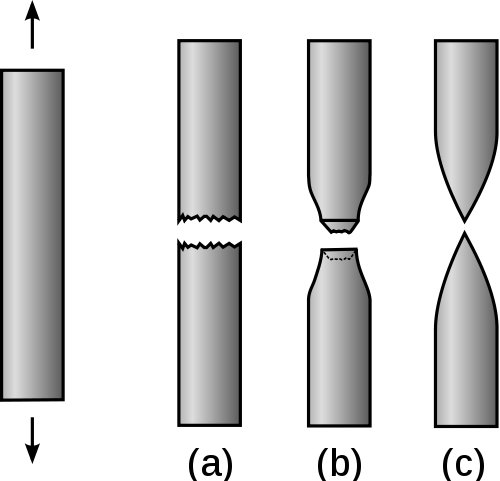Ductility is an important property in the world of lifting. Chains
and lifting components, for example, consist of an alloy that not only
makes the steel stronger but also gives it more ductility. Ductility is
an important factor in the design and manufacture of lifting and
hoisting materials. A higher degree of formability ensures greater
safety. But what exactly is ductility and why does it improve safety?
First of all, we will explain tensile strength before we move on to
ductility. Tensile strength is the maximum mechanical load of a
material. When the maximum tensile strength of a material - in this case
steel - is reached, it will start to contract and eventually break. The
stronger the material, the more load it can withstand.
For example, Grade 8 steel is made from a Cr-Ni-Mo alloy that is
hardened and stress relieved. The steel is stress relieved during
tempering, but the hardness is also reduced in a controlled manner to
increase formability and impact resistance. The risk of embrittlement
such as stress corrosion cracking and hydrogen embrittlement is thus
reduced. The term "Grade" indicates the nominal breaking load, expressed
in Newtons per mm², for this material type. For Grade 8, this is
800N/mm².
Of course, one does not want a chain to break into two parts immediately
after exceeding the maximum tensile strength. Ductility is the ability
of a metal to deform under tensile stress. For example, ductile metals
can easily be pulled into a wire under tension.
Ductile materials have high toughness. The opposite of ductile materials
are brittle materials. These are materials that immediately break when
they reach their maximum tensile strength. Brittle materials are
referred to as non-ductile materials.

Pictured are materials that change from left to right from brittle to
tough, from non ductile to ductile. Chain (a) breaks without any
deformation. Chain (b) breaks with very little deformation. Both chains
are essentially low deformability. Chain (c) on the other hand has high
ductility and will deform before breaking.
The industry standard is that lifting components should have a minimum
formability of 20%. This percentage ensures that the deformation can
always be clearly seen and thus provides more safety.
A "safe" lifting chain or hook will therefore first show a visual
deformation before breaking. This ensures that timely action can be
taken before tragic accidents happen. It is also important that a visual
check is always carried out on lifting and hoisting equipment before it
is put into use. Lifting and hoisting equipment which has been
subjected to loads exceeding its maximum tensile strength will stretch
and deform due to its ductile properties. However, the deformation that
has occurred will not disappear when the tension is removed. Whenever
deformation is noticed, the material must be taken out of service
immediately.